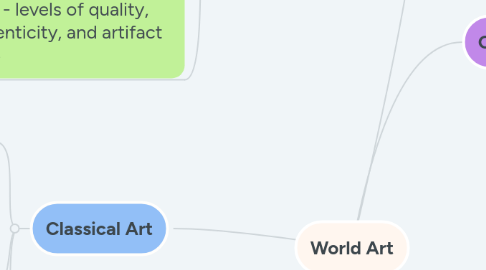World Art
by Han Hall


1. The Origins of Art
1.1. connoisseurship: principles to evaluate content, composition, and style of art pieces - influenced the hierarchy of what is considered art/craft or fine art/artifact
1.2. ethnocentrism: belief one's culture is superior and altogether more advanced than underdeveloped countries
1.3. concepts of art helped to distinguish elite and lower class - levels of quality, authenticity, and artifact value
2. Classical Art
2.1. Hellenomania: fetishism of ancient Greek art, reflections of the development of art history
2.2. Zeitgeist: "spirit of the age", spirit of the culture is created in the struggle of the individual
2.3. Hegel Theory: changed perspectives of classic and contemporary form - continuous flow of thesis, antithesis, and synthesis
3. Primitive Art
3.1. heavily focused on the primal stages of human development
3.2. Typology: arranging artifacts from around the world in sequence, grouped by functional type rather than cultural and historical categories
3.2.1. ex: Pitt Rivers Museum, England
3.3. Primitive: meaning original, pure, simple - described in Western culture with condescending terms (they had developed past the phenomena of primal art)
4. Oriental Art
4.1. Indian art challenges Western perspectives: art is developed from within, "spirit of divinity"
4.2. European opinions: not considered fine art, strayed classical art traditions
4.3. Western critics were ignorant of the values and standards in Oriental art
5. Prehistoric Art
5.1. Cycle of Ages
5.1.1. The Drift: lived in the wild as hunters and gathers
5.1.2. Stone Age: period of polished stone and flint
5.1.3. Bronze Age: bronze used for arms and tools
5.1.4. Iron Age: iron replacing bronze
